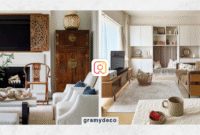The Art of Creating Meaningful Spaces With Simple Decorations invites you to explore the fascinating world of interior design where simplicity meets significance. As we navigate through the various elements that contribute to space-making, we’ll uncover how thoughtful decorations can transform ordinary environments into personalized havens. Whether it’s through color, texture, or the careful selection of decor pieces, creating a meaningful space can profoundly impact our daily lives, enhancing our well-being and inviting connection.
With an understanding of the power of minimalism and the importance of personal touch in design, this discussion aims to empower you to make your surroundings resonate with meaning. Simple decorations are not just about aesthetics; they carry stories, reflect personalities, and create atmospheres that foster comfort and inspiration. Join us as we delve into practical tips and creative ideas for crafting spaces that truly feel like home.
In the ever-evolving landscape of technology and communication, the way we interact with each other has undergone significant transformations over the past few decades. From the advent of the internet to the rise of social media platforms, our methods of connecting and sharing information have been dramatically altered. This article will delve into the nuances of modern communication, exploring its implications on relationships, businesses, and society at large.
The Digital Age: A Brief Overview
The Digital Age, often referred to as the Information Age, began in the late 20th century with the proliferation of digital technology. The introduction of personal computers and the internet revolutionized how we access and distribute information. Suddenly, people could communicate across vast distances with just a few clicks. Emails replaced traditional letters, instant messaging took over phone calls, and social media began to shape our interactions in unprecedented ways.
One of the most significant changes has been the emergence of social media platforms. Facebook, Twitter, Instagram, and LinkedIn, to name a few, have created spaces where individuals share their lives, thoughts, and work with a global audience. These platforms have not only transformed personal communication but also influenced business practices, marketing strategies, and even political discourse.
The Impact on Personal Relationships
Modern communication tools have dramatically changed how we maintain relationships. In the past, staying connected with friends and family who lived far away required letters or expensive long-distance calls. Now, with video calling, instant messaging, and social media, staying in touch is easier than ever. However, this ease of communication comes with its own set of challenges.
On one hand, technology has made it possible to connect with loved ones instantly, regardless of distance. Families can share experiences in real time, celebrating milestones together through video calls or social media updates. On the other hand, the rise of digital communication has introduced a paradox where individuals may feel more isolated despite being constantly connected. The quality of interactions can diminish when conversations happen through screens rather than face-to-face, leading to misunderstandings and a lack of emotional depth.
Furthermore, the pressure to maintain a curated online presence can affect how people perceive their relationships. Social media often presents an idealized version of life, leading to comparisons that can foster feelings of inadequacy or jealousy. As a result, individuals may find themselves navigating the complexities of both online personas and genuine connections, creating a landscape where authenticity is often questioned.
Communication in the Workplace
In the realm of business, modern communication tools have reshaped workplace dynamics. The shift from traditional office environments to remote work has accelerated the need for effective digital communication strategies. Tools like Slack, Microsoft Teams, and Zoom have become essential for collaboration and project management, allowing teams to work together seamlessly, regardless of their physical locations.
However, the digital workplace also presents challenges. The potential for miscommunication rises when interactions occur through text-based platforms, where tone and nuance can easily be lost. Additionally, the constant influx of messages and notifications can lead to information overload, making it difficult for employees to focus and prioritize tasks effectively.
Moreover, the reliance on digital communication can sometimes hinder relationship-building among colleagues. Watercooler conversations and casual interactions that occur naturally in an office setting are harder to replicate online. As a result, organizations must be intentional about fostering a sense of community and connection among remote team members.
The Role of Social Media in Society
Social media plays a critical role in shaping societal trends and attitudes. It serves as a platform for individuals to express their opinions, share news, and mobilize for causes they believe in. Movements like #MeToo and Black Lives Matter gained momentum through social media, highlighting its power in raising awareness and driving social change.
However, the influence of social media is not without its drawbacks. The spread of misinformation and polarized discussions can create echo chambers where individuals only engage with viewpoints that align with their own. This can contribute to divisive narratives and hinder constructive dialogue between opposing perspectives.
As users engage with social media, they must also grapple with issues related to privacy and data security. High-profile scandals involving data breaches and the misuse of personal information have raised concerns about how personal data is collected, stored, and utilized by tech companies. This has led to calls for greater transparency and regulation in the digital space.
Navigating Modern Communication: Tips for Success
To thrive in the landscape of modern communication, it’s essential to adopt strategies that enhance both personal and professional interactions. Here are some tips for navigating this complex terrain:
1. Prioritize Face-to-Face Interactions: Whenever possible, opt for in-person meetings or video calls rather than relying solely on text-based communication. This helps to convey tone and emotion more effectively.
2. Be Mindful of Digital Etiquette: Practice respectful communication by being clear and considerate in your messages. Take the time to proofread your texts and emails to avoid misunderstandings.
3. Set Boundaries: In a world where you are constantly connected, it’s important to set boundaries around your availability. Designate specific times for checking emails and messages to prevent burnout.
4. Encourage Open Dialogue: Foster an environment where team members feel comfortable sharing their thoughts and concerns. This can lead to more productive conversations and stronger relationships.
5. Stay Informed: Keep abreast of the latest developments in technology and social media trends to leverage these tools effectively in your communication strategies.
6. Cultivate Authenticity: Strive for authenticity in your interactions, both online and offline. Share your true self and be open about your experiences, which can foster deeper connections with others.
7. Be Aware of Misinformation: Approach information shared on social media critically. Verify sources and fact-check before sharing content to contribute to a more informed online community.
Conclusion
The evolution of communication in the digital age has transformed how we connect with one another, both personally and professionally. While technology has made it easier to communicate across distances, it has also introduced challenges that require us to be more intentional about our interactions. By understanding the nuances of modern communication and implementing strategies to enhance our connections, we can navigate this complex landscape and foster meaningful relationships in an increasingly digital world. As we move forward, it’s vital to embrace the benefits of technology while remaining mindful of its potential pitfalls, ensuring that our communication remains authentic, respectful, and impactful.
In conclusion, The Art of Creating Meaningful Spaces With Simple Decorations emphasizes the profound impact that thoughtfully chosen decor can have on our living environments. By embracing simplicity and personal significance, we can cultivate spaces that not only look beautiful but also reflect our unique identities and stories. As you embark on your journey to transform your surroundings, remember that every small detail counts, and each decoration has the potential to create a lasting impression.
General Inquiries: The Art Of Creating Meaningful Spaces With Simple Decorations
What are some simple decoration ideas to start with?
Consider adding personal artwork, using plants for a touch of nature, or incorporating soft textiles like cushions and throws.
How can I make a small space feel more meaningful?

Use multifunctional furniture, opt for a cohesive color palette, and display items that tell your story, like travel souvenirs or family photos.
Is it possible to create meaningful spaces on a budget?
Absolutely! Thrift stores and DIY projects can offer unique decor options that are both affordable and personal.
What role does lighting play in creating meaningful spaces?
Lighting can dramatically change the mood of a space; consider using warm tones and layer your lighting to create a cozy atmosphere.
How often should I update my decorations?
There’s no set rule, but refreshing your space seasonally or whenever you feel inspired can keep your environment feeling current and meaningful.



